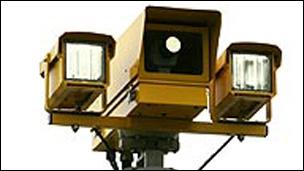Average speed cameras 'will make A9 safer'
- Published

Campaigners say average speed cameras will not address problems with the A9
Average speed cameras on a 138 mile (222km) stretch of the A9 will help to reduce the risk of accidents, senior police and transport officials say.
The devices are to be installed between Dunblane and Inverness next year.
The Real A9 Users campaign opposes the move, arguing that it will slow traffic down and lead to motorists making dangerous overtaking manoeuvres.
Supt Iain Murray and Transport Scotland's Stewart Leggett said cameras will have a positive impact.
According to government agency Transport Scotland's figures, one in three cars and 95% of HGVs are driven at speeds above the national limit on the A9.
Police Scotland's Supt Murray said: "Road user behaviour is what concerns me the most.
"Within that there is speed and also overtaking and basically how we interact with each other on the roads.
"Average speed cameras will change behaviour because it will moderate how people drive, how they speed, changes expectation around journey times and around overtaking."
Mr Leggett said ensuring HGVs were driven at a limit of 40mph had informed the decision to install the cameras.
He added: "Retaining the 40mph creates the safest environment, making it a lot safer to overtake."
The Real A9 Users campaign, which has a 20 point plan on how the road could be made safer, said allowing lorries to be driven at up to 50mph would ease traffic flows on the route.
Spokesman Mike Burns said: "The main issue that seems to be arising is driver frustration, caused by slow moving vehicle queues, poor road maintenance, poor road signage and a lack of police presence."
"Speed doesn't seem to be a factor in the accidents. We would agree that bad overtaking is a root of a lot of the accidents on the A9."
- Published14 August 2013
- Published2 August 2013
- Published26 July 2013
- Published19 July 2013
- Published12 July 2013
- Published3 July 2013